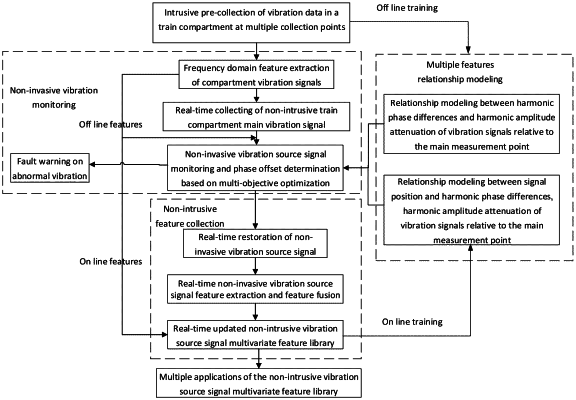| CPC G01H 1/00 (2013.01) [B61L 15/0081 (2013.01)] | 10 Claims |

|
1. A non-intrusive train compartment vibration monitoring method, comprising the following steps:
step 1, under the conditions of normal vibration and abnormal vibration of known vibration sources outside a train compartment, pre-collecting vibration data M of a plurality of sub measurement points in the train compartment in transverse, longitudinal and vertical directions, pre-collecting vibration data C of a main measurement point in the train compartment in transverse, longitudinal and verticals, and pre-collecting vibration data S of each known vibration source outside the train compartment in transverse, longitudinal and vertical directions;
step 2, extracting phase information and amplitude information of 1˜J-order harmonic signals of the vibration data M of each sub measurement point, extracting phase information and amplitude information of 1˜-J-order harmonic signals of the vibration data C of the main measurement point, and extracting phase information and amplitude information of 1˜J-order harmonic signals of each known vibration source;
step 3, training a first model by a machine learning algorithm, with 1˜J-order harmonic phase differences and harmonic amplitude ratios between the vibration data of each non-main measurement point and the vibration data of the main measurement point as input, and position information of each non-main measurement point in the transverse, longitudinal and vertical directions relative to the main measurement point as output;
training a second model by a machine learning algorithm, with 1˜J-order harmonic phase differences between the vibration data of each non-main measurement point and the vibration data of the main measurement point as input, and 1˜J-order harmonic amplitude ratios between the vibration data of each non-main measurement point and the vibration data of the main measurement point as output;
wherein the non-main measurement points are composed of the sub measurement points and the known vibration sources;
step 4, collecting real-time vibration data CR of the main measurement point in the transverse, longitudinal and vertical directions;
step 5, setting optimization objectives with phase offsets of vibration sources relative to the main measurement point, a combined working state of the known vibration sources, and abnormal vibration types as independent variables, executing a multi-objective optimization algorithm based on the first model and the second model, and outputting vibration monitoring result information of the train compartment, the vibration monitoring result information including positions of vibration sources that are vibrating and/or abnormal vibration types of vibration sources that are vibrating and/or 1˜J-order harmonic phase offsets of vibration sources that are vibrating relative to the main measurement point and/or 1˜J-order harmonic amplitude ratios of vibration sources that are vibrating relative to the main measurement point.
|